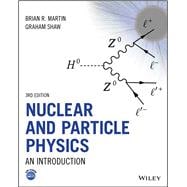Updated and expanded edition of this well-known Physics textbook provides an excellent Undergraduate introduction to the field
This new edition of Nuclear and Particle Physics continues the standards established by its predecessors, offering a comprehensive and highly readable overview of both the theoretical and experimental areas of these fields. The updated and expanded text covers a very wide range of topics in particle and nuclear physics, with an emphasis on the phenomenological approach to understanding experimental data. It is one of the few publications currently available that gives equal treatment to both fields, while remaining accessible to undergraduates.
Early chapters cover basic concepts of nuclear and particle physics, before describing their respective phenomenologies and experimental methods. Later chapters interpret data through models and theories, such as the standard model of particle physics, and the liquid drop and shell models of nuclear physics, and also discuss many applications of both fields. The concluding two chapters deal with practical applications and outstanding issues, including extensions to the standard model, implications for particle astrophysics, improvements in medical imaging, and prospects for power production. There are a number of useful appendices. Other notable features include:
- New or expanded coverage of developments in relevant fields, such as the discovery of the Higgs boson, recent results in neutrino physics, research to test theories beyond the standard model (such as supersymmetry), and important technical advances, such as Penning traps used for high-precision measurements of nuclear masses.
- Practice problems at the end of chapters (excluding the last chapter) with solutions to selected problems provided in an appendix, as well as an extensive list of references for further reading.
- Companion website with solutions (odd-numbered problems for students, all problems for instructors), PowerPoint lecture slides, and other resources.
As with previous editions, the balanced coverage and additional resources provided, makes Nuclear and Particle Physics an excellent foundation for advanced undergraduate courses, or a valuable general reference text for early graduate studies.








